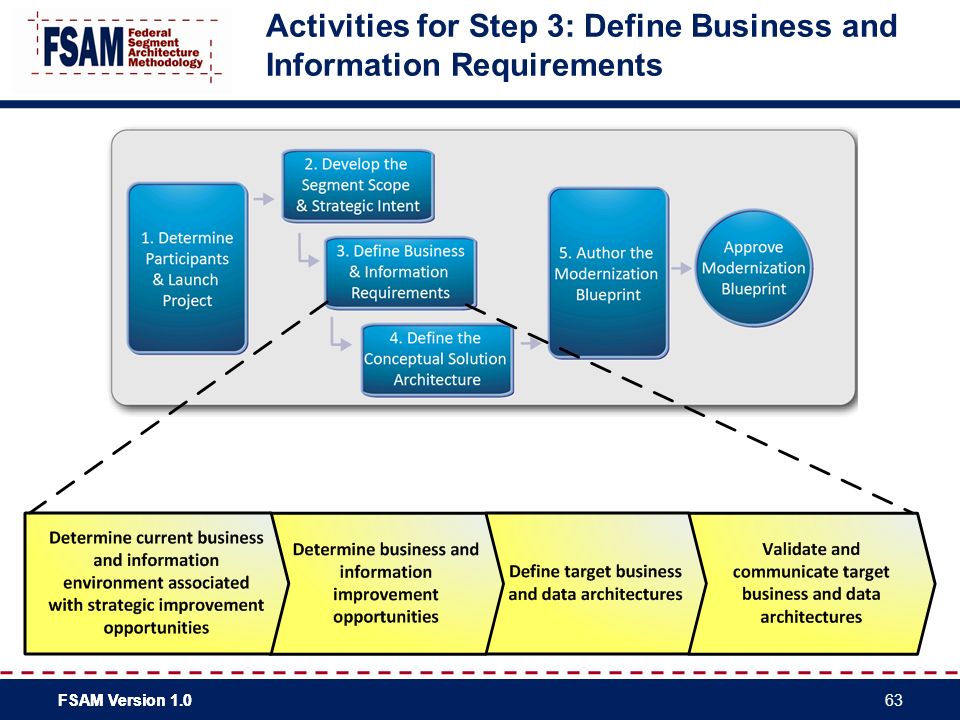Before we begin, a quick walkthrough on the two major terms used here. The Collaborative Planning Methodology (CPM) is a comprehensive set of guidelines for planning and enterprise roadmapping. In other words, it helps businesses transform themselves and then implement their new ideas successfully. Meanwhile, the Federal Segment Architecture Methodology (FSAM) is a step-by-step process for developing and using segment architectures. Much like CPM, it serves as a roadmap creator for businesses looking to transform and reinvent themselves.
The US federal government uses these methodologies to define needs for organizations and projects. They also identify what will be done to address those needs, when actions will be taken, how much it will cost, what benefits will be achieved, when those benefits will be achieved, and how those benefits will be measured (view this link, to learn more). In doing so, these methodologies help create more guided and efficient organizations and programs.
A “new’ 2012 CPM will be the replacement for the 2008 FSAM. FSAM, meanwhile, is primarily sourced from the 2006 Methodology for Business Transformation (MBT) method. This new CPM was incorporated into the updated FEA Common Guidance in May of 2012. Typically, CPMs have two primary groundings. (1) The EA Cube which Dr. Scott Bernard has been leading development with his first publication in 2004. (2) Taking the management workflow principles of FSAM.
So What?
Xentity has blogged on the history of FSAM from 2008-2012. This was begat by MBT 2005-2007 at the Department of the Interior (DOI). And that was begat by the Trade Agreements Act (TAA) at the Bureau of Land Management (BLM) in 2002-2003. All three acts and organizations leverage best practices from methods, approaches, frameworks, maturity models, etc. In doing so, they allow problem reduction from Enterprise Planning to incorporate business focus area tactical segment improvements. These improvements are doable within current budget and future budgets.
For instance, MBT work products were mapped to supported various architecture frameworks (FEAF, DODAF, TOGAF, C4ISR). Then, FSAM mapped into various other IT Portfolio planning (CPIC, A&A, Privacy). MBT also was build with the premise of linking segment architecture to the IT Investment Maturity Framework. Mapping CPM to bring in larger communities will be interesting. It will also be interesting to see what carries over into CPM from its predecessors
What Has Carried On To The CPM From FSAM And MBT?
Looking back, there is a sort of sense of comparing the maturing style of the planning as disruptions move SO MUCH faster over ten years. We still break down CPM the same way as MBT and FSAM even with the complexity burden pie chart. The 5 major steps (referenced here on pages 13-18) remain intact albeit with re-branded names. For example, the Step 4 from all 3 are similar in “Definition”, yet the level of definition changed the audience from Implementer Guidance to Portfolio Manager to Investment Sponsor. See:
- CPM Step 3.3 (2014): Step Title: Define and Plan
- FSAM Step 3 (2008): Step Title: Define Business and Information Requirements
- MBT Step 3 (2005-2007): Step Title: Analyze the Business and Define the Target Business Environment
There are a lot of similarities, sure. However, one can see the appropriate move from system architecting to portfolio designing to roadmapping.
But Why Something New, If Segment Methods Are So Great? Paralysis Analysis Was Exactly What Happened
Both MBT and FSAM did stumble slightly when initially presented. Consequently, they usually implemented incorrectly. It was too much of a “waterfall” method to assure all linked Federal compliance gates were hit in a serial fashion (CPIC, PIA, Security). This was where paralysis analysis happened. Both methods overanalyzed, resulting in incorrect implementation. Furthermore, MBT and FSAM intended more an approach menu than a prescripted menu of thou shalt steps. This comes back to very early discussions in 2005 on the naming and use of the term “Methodology” – does the term infer prescription or direction or suggestion? It appears to been the former, and many FSAM and even many MBT implementations interpreted to must do all steps versus execute in the Step 1 selection of must-have activities.
Furthermore, only a few groups like the Center for Disease Control (CDC) and U.S Geological Survey (USGS) developed an Agile or adapted version of FSAM to do the products needed required at the right time. MBT had a similar curse. It could take 6-9 months to get to a 3-5 year plan, which is hard to fathom now!
Some Things to Look Forward To
As of this writing the DOI Geospatial Modernization Blueprint is still being implemented and still is relevant as the tact there was more like the CPM intent – the business and data investment issues are as relevant today as when the Geospatial blueprint started on MBT 1.0. Yet, even the cited Geospatial blueprint, while completed, its tenets stand and rarely receive challenges. The support and sponsorship for implementation mostly retired or changed positions. Consequently, MBT sorely missed the soft science side of transformation in this situation. In working with DOI, Xentity helped capture these as Transformation Lab Services to get more agile shorter, more tactical wins in change.
While Xentity believes the Segment Architecture is the usual go-to approach for moving towards shared services transformation, blending with the Lab Services or Solution Analysis type engagements have been found to be more successful. Train on the toolkit, but use the tools needed for a smaller set of scope that can been showcased in a Fiscal Year timeframe to assure sponsorship remains engaged. And of course, if there is anyone struggling with this and not afraid to admit it, we are always happy to provide aid in helping you understand these approaches, because we get that it can come across as complicated.



